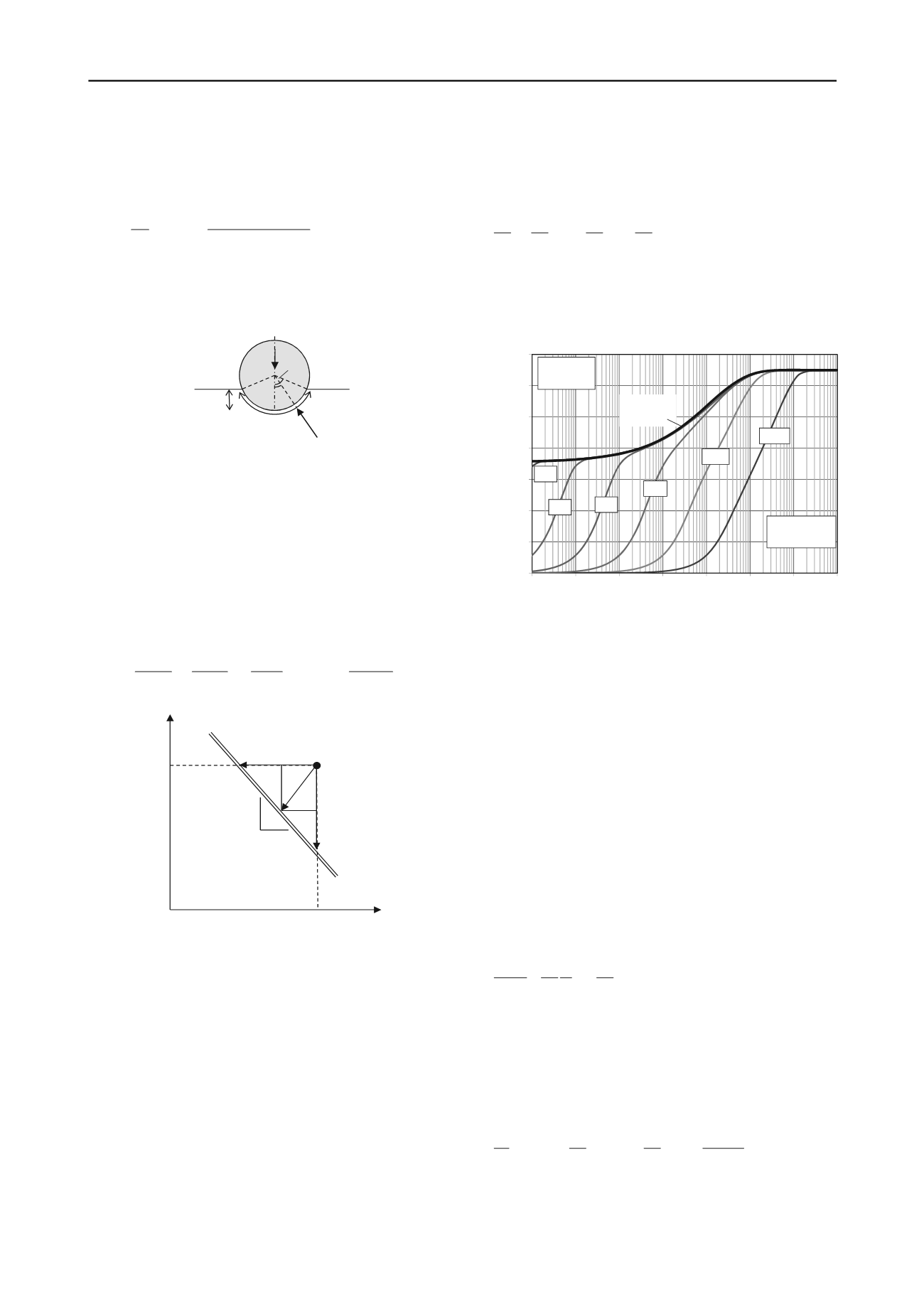
100
Proceedings of the 18
th
International Conference on Soil Mechanics and Geotechnical Engineering, Paris 2013
Proceedings of the 18
th
International Conference on Soil Mechanics and Geotechnical Engineering, Paris 2013
normal effective stresses around the perimeter, P, of the
interface, with S adjusted to balance the submerged pipeline
weight, W', allows the average normal effective stress, q, to be
expressed as
D/2
DP and
1.27
cos
sin
sin2
with
P
W q
m
m m
m
m
(38)
The value of
m
is related to the normalised embedment by
cos
m
= 1 - 2w/D.
Pipe
diameter D
w
m
P
n
' ~ Scos
W'
Figure 22 Schematic of embedded pipe.
Within a conventional critical state framework, the effect of
the time scale for axial movement may be evaluated by
considering the tendency for the adjacent soil to compact, or
dilate, and the resulting maximum (in an absolute sense) excess
pore pressure that may develop during rapid shearing. This is
illustrated in Figure 23 for the case of contractive soil. The
potential maximum reduction in void ratio, -
e
max
, during
drained shearing is equivalent to a state parameter (Been and
Jefferies 1985), although more usefully expressed in terms of
volumetric strain,
v,max
. The corresponding maximum excess
pore pressure during undrained shearing is then obtained from
*
e1
e
q
u
1 ln
max ,v
max ,v
0
max
max
(39)
ln
'
n
e
e
max
q
e
0
u
max
u
e
critical
state line
Figure 23 Critical state framework for stress paths during shearing.
The proportion of
u
max
that develops at the pipeline-soil
interface depends on the velocity and time scale (or cumulative
displacement) of the axial motion. For slow movement, excess
pore pressure can dissipate as fast as it is generated, and the
response is fully drained, while at the opposite extreme high
excess pore pressures are generated initially, although should
dissipate with continued displacement.
An example response is shown in Figure 24 from FE
analysis of a pipeline resting on normally consolidated Modified
Cam Clay, with a plane strain friction angle of 27 º (Randolph
et al. 2012). The theoretical wedging factor for w/D = 0.4 is
1.25, so that the drained axial friction factor is F/W' ~
1.25tan(27) = 0.64. For fast shearing the initial excess pore
pressure ratio,
u
max
/q, is about 0.45, so that the undrained
friction ratio is (1 – 0.45)×0.64 = 0.35.
With increasing elapsed time, or displacement (noting that
c
v
t/D
2
is equivalent to (
/D)/(vD/c
v
)), the excess pore pressures
dissipate and the friction ratio increases to the drained value.
The form of the backbone curve that quantifies the degree of
consolidation as a function of T = c
v
t/D
2
may be approximated
as (Randolph et al. 2012):
m
50
T/T)2 ln(
u
d
d
e
'W
F
'W
F
'W
F
'W
F
(40)
where the subscripts d and u denote drained and undrained
limits, m ~ 0.5 and T
50
, representing the non-dimensional time
where the friction ratio is midway between drained and
undrained limits, is about 0.05.
0
0.1
0.2
0.3
0.4
0.5
0.6
0.7
0.00001 0.0001 0.001 0.01 0.1
1
10
100
Mobilised axial friction, F/W'
c
v
t/D
2
Pipe
w/D = 0.4
0.0039
0.039
0.39
3.9
39
390
Values
of vD/c
v
as indicated
Backbone
curve fit
Figure 24 Example axial response of pipeline as a function of non-
dimensional time and velocity.
Unfortunately, data from extensive model tests on pipe
segments are not consistent with the theoretical framework of
critical state soil mechanics and consolidation described above.
The data show that excess pore pressures may be regenerated
during fast axial motion that follows slow, drained, axial
displacement, and indeed the axial friction has generally been
considered as a function of the shearing velocity rather than the
elapsed time during a given motion (White et al. 2011).
A model that broadly reproduces the trends observed in the
model tests was suggested by Randolph et al. (2012). The
model supposes that pore pressure is continuously generated
during shearing, in response to volumetric collapse (generically
referred to as ‘damage’) within the soil adjacent to the pipe. The
rate of (potential) volumetric strain was assumed proportional to
the shear strain rate (denoted by normalised velocity, v/D) and
to the current normal effective stress, so that no further damage
would occur if the effective stress were to fall to zero. Taking
the rate of volumetric collapse (or damage) as
v/D, the rate of
excess pore pressure generation becomes
q
u 1
D
v
*
q
dt /du
(41)
At high rates of shearing, the effect of damage is partially
compensated by slight enhancement of the effective friction
ratio due to increased shear strain rates. This may be modelled
using standard models for rate dependency of shear strength, for
example a form of Herschel-Bulkley relationship, so that the
failure shear stress ratio becomes
D/
v
D/v
1
q
u 1
q
u 1
q
ref
y
HB
f
(42)


